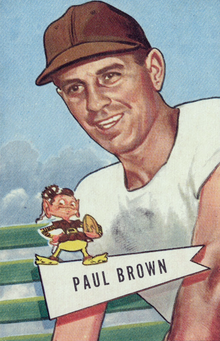
Back بول براون Arabic بول براون (كاتب) ARZ Paul Brown (Footballtrainer) German Paul Brown Spanish Paul Brown (amerikkalaisen jalkapallon valmentaja) Finnish Paul Brown French Paul Brown (allenatore) Italian ポール・ブラウン (アメリカンフットボール) Japanese Paul Brown Portuguese Браун, Пол Юджин Russian
 Brown on a 1952 football card | |
| Personal information | |
|---|---|
| Born: | September 7, 1908 Norwalk, Ohio, U.S. |
| Died: | August 5, 1991 (aged 82) Cincinnati, Ohio, U.S. |
| Career information | |
| High school: | Massillon Washington (Massillon, Ohio) |
| College: | Miami (OH) |
| Career history | |
| As a coach: | |
| |
| As an executive: | |
| |
| Career highlights and awards | |
| |
| Head coaching record | |
| Regular season: | 213–104–9 (.667) |
| Postseason: | 9–8 (.529) |
| Career: | 33–13–3 (.704) (college) 222–112–9 (.660) (pro) |
| Coaching stats at PFR | |
Paul Eugene Brown (September 7, 1908 – August 5, 1991) was an American football coach and executive in the All-America Football Conference (AAFC) and National Football League (NFL). Brown was both the co-founder and first coach of the Cleveland Browns, a team named after him, and later co-founded the Cincinnati Bengals. His teams won seven league championships in a professional coaching career spanning 25 seasons.
Brown began his coaching career at Severn School in 1931 before becoming the head football coach at Massillon Washington High School in Massillon, Ohio, where he grew up. His high school teams lost only 10 games in 11 seasons. He was then hired at Ohio State University and coached the school to its first national football championship in 1942. After World War II, he became head coach of the Browns, who won all four AAFC championships before joining the NFL in 1950. Brown coached the Browns to three NFL championships — in 1950, 1954 and 1955 — but was fired in January 1963 amid a power struggle with team owner Art Modell. In 1968, Brown co-founded and was the first coach of the Bengals. He retired from coaching in 1975 but remained the Bengals' team president until his death in 1991. The Bengals named their home stadium Paul Brown Stadium in his honor. He was inducted into the Pro Football Hall of Fame in 1967.
Brown is credited with a number of American football innovations. He was the first coach to use game film to scout opponents, hire a full-time staff of assistants, and test players on their knowledge of a playbook.[1] He invented the modern face mask, the practice squad and the draw play. He also played a role in breaking professional football's color barrier, bringing the first African-Americans to play pro football in the modern era onto his teams.[2][3][4][5][6] Despite these accomplishments, Brown was not universally liked.[7] He was strict and controlling, which often brought him into conflict with players who wanted a greater say in play-calling. These disputes, combined with Brown's failure to consult Modell on major personnel decisions, led to his firing as the Browns' coach in 1963.[8]
- ^ Cantor 2008, p. 3.
- ^ Cantor 2008, p. 4.
- ^ Rhoden, William C. (1997-09-25). "ON PRO FOOTBALL; When Paul Brown Smashed the Color Barrier". The New York Times. ISSN 0362-4331. Retrieved 2022-12-27.
- ^ Maule, Tex. "A MAN FOR THIS SEASON". Sports Illustrated Vault | SI.com. Retrieved 2022-12-27.
- ^ Marc Bona, cleveland com (2016-02-09). "Paul Brown and racial integration: Museum's latest exhibit". cleveland. Retrieved 2022-12-27.
- ^ Shuck, Barry (2021-07-17). "Changing pro football's color barrier: Paul Brown hires Bill Willis and Marion Motley". Dawgs By Nature. Retrieved 2022-12-27.
- ^ Keim 1999, pp. 17–18.
- ^ Pluto 1997, p. 293.
© MMXXIII Rich X Search. We shall prevail. All rights reserved. Rich X Search